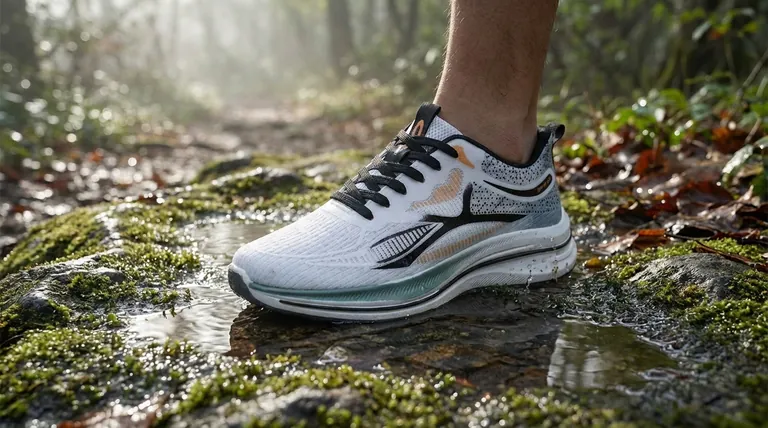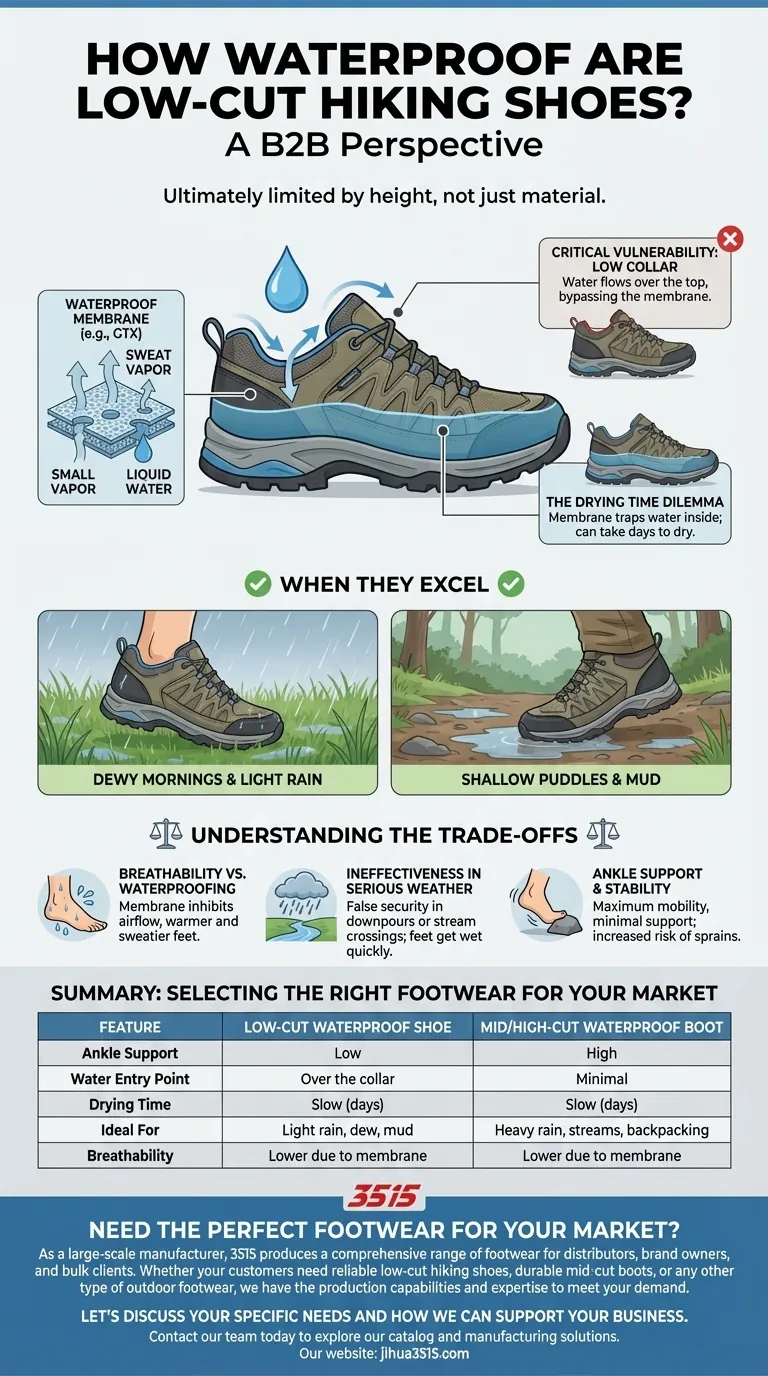Ultimately, the waterproofness of a low-cut hiking shoe is limited by its height. While the materials themselves have a waterproof membrane that effectively blocks water from shallow puddles or light rain, their primary weakness is the low collar. Any significant splash, stream crossing, or heavy downpour will allow water to enter over the top of the shoe.
The term "waterproof" on a low-cut shoe refers to the fabric's ability to repel water, not the shoe's ability to keep your foot dry in all wet conditions. The low ankle opening remains the critical point of failure.

The Anatomy of a "Waterproof" Shoe
To understand the limits of a low-cut waterproof shoe, you need to understand how it's constructed and where its vulnerabilities lie.
The Waterproof Membrane
Most waterproof hiking shoes use a membrane, like Gore-Tex (GTX), built into the shoe's lining. This is a thin layer with microscopic pores large enough for water vapor (sweat) to escape but too small for liquid water droplets to penetrate. This technology is highly effective at what it does.
The Critical Vulnerability: The Collar
The shoe's low cut is its defining feature and its greatest weakness in wet weather. Water doesn't need to seep through the fabric; it simply flows over the low ankle collar and down into the shoe, completely bypassing the waterproof membrane.
The Drying Time Dilemma
Once water gets inside a waterproof shoe—either over the collar or through sweat—it has almost no way to get out. The very membrane designed to keep water out also traps it inside, meaning these shoes can take days to dry out completely.
When Low-Cut Waterproof Shoes Excel
Despite their limitations, these shoes are the ideal choice for specific conditions where their benefits of mobility and low weight shine.
For Dewy Mornings and Light Rain
They are perfect for hikes through wet grass or in a light drizzle. The membrane will keep your feet dry from moisture that contacts the shoe's upper material directly.
For Shallow Puddles and Mud
If you're hiking on well-maintained trails with occasional shallow puddles or muddy sections, a low-cut waterproof shoe provides all the protection you need from splashes from below.
Understanding the Trade-offs
Choosing footwear is always a balance of competing priorities. A waterproof low-cut shoe is not a universally superior option; it comes with significant trade-offs.
Breathability vs. Waterproofing
The waterproof membrane that blocks water also inhibits airflow. This means your feet will be warmer and sweat more than in a non-waterproof shoe, which can lead to discomfort and blisters even on a dry day.
Ineffectiveness in Serious Weather
In a sustained downpour or on a trail with unavoidable stream crossings, a low-cut waterproof shoe offers a false sense of security. Your feet will get wet quickly as water pours over the collar.
Ankle Support and Stability
The low-cut design offers maximum ankle flexibility and mobility but provides minimal support. This increases the risk of ankle twists and sprains, especially for less experienced hikers or those carrying a heavy pack on uneven terrain.
Making the Right Choice for Your Hike
To select the right footwear, you must honestly assess the conditions you will most likely face.
- If your primary focus is day hiking on established trails in mostly fair weather: A low-cut waterproof shoe offers a great balance of protection and comfort.
- If your primary focus is backpacking in rainy climates or crossing streams: A mid or high-cut waterproof boot is a far more reliable choice to keep your feet dry.
- If your primary focus is hiking in hot weather or extremely wet environments: A non-waterproof, highly breathable trail runner is often superior, as it will dry exceptionally fast after getting wet.
Choosing the right shoe means matching the tool to the specific demands of the trail and the environment.
Summary Table:
| Feature | Low-Cut Waterproof Shoe | Mid/High-Cut Waterproof Boot |
|---|---|---|
| Ankle Support | Low | High |
| Water Entry Point | Over the collar | Minimal |
| Drying Time | Slow (days) | Slow (days) |
| Ideal For | Light rain, dew, mud | Heavy rain, streams, backpacking |
| Breathability | Lower due to membrane | Lower due to membrane |
Need the Perfect Footwear for Your Market?
As a large-scale manufacturer, 3515 produces a comprehensive range of footwear for distributors, brand owners, and bulk clients. Whether your customers need reliable low-cut hiking shoes, durable mid-cut boots, or any other type of outdoor footwear, we have the production capabilities and expertise to meet your demand.
Let’s discuss your specific needs and how we can support your business.
Contact our team today to explore our catalog and manufacturing solutions.
Visual Guide

Related Products
- Wholesale Breathable Athletic Sneakers - Custom Lightweight Cushioned Footwear Manufacturer
- Wholesale Lightweight Cushioned Athletic Sneakers for Custom Bulk Production
- Wholesale Durable Camouflage Canvas Shoes with High-Traction Cleated Rubber Sole
- Durable Rubber-Soled Utility Shoes for Wholesale & Custom Brand Manufacturing
- Wholesale Breathable Training Shoes Custom Athletic Footwear Manufacturer
People Also Ask
- How should you choose the right type of athletic shoe? Match Your Sport for Peak Performance
- What are the key characteristics of mesh sneakers? Lightweight, Breathable, and Versatile Footwear Explained
- Why are running shoes and walking shoes not interchangeable? Avoid Injury with the Right Footwear
- What are the benefits of breathable mesh in shoe design? Enhance Comfort and Performance
- Can running shoes be used for walking? Choosing the Right Footwear for Comfort & Support



















